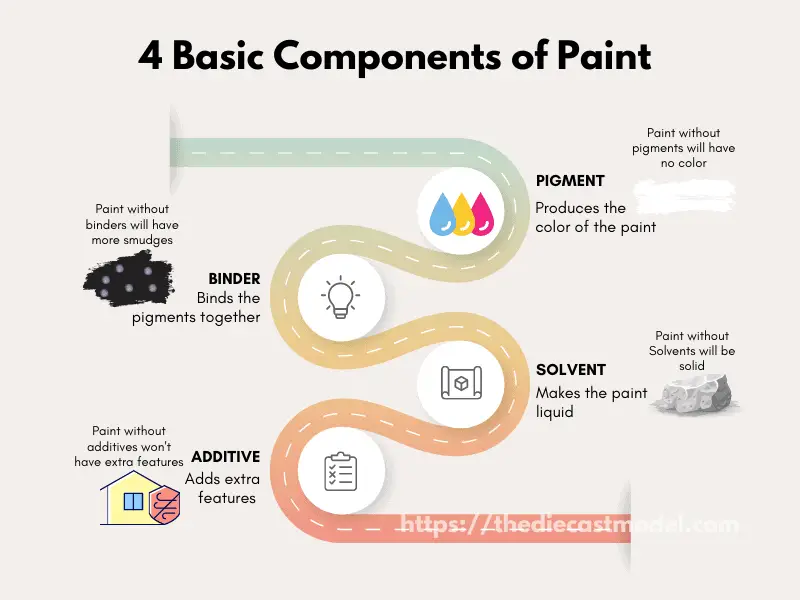Can You Mix Enamel and Acrylic Paint? A Look into the Reaction of Both Paints
Some artists enjoy the versatility of using acrylic paint, as you can mix it with just about anything. However, they often wonder what would happen if they were to mix enamel paint with acrylic paint? Can you really mix these two types of paints together? We will talk about the answer in this blog post.
You can’t mix enamel and acrylic paint because their solvents aren’t compatible. Generally speaking, enamel paint is oil-based, while acrylic paint is water-based. This means the solvents of these paints need to be oil or water-soluble. Since oil and water don’t mix well, these paints can’t be combined.
This blog post will talk about why acrylic and enamel paints aren’t compatible with each other. Then, we will talk about the chemical composition of paints and what makes these paint not react with each other. Lastly, we will talk about the differences between the paints and if we can use acrylic over enamel and vice versa.

Does enamel paint react with acrylic?
Enamel paint and acrylic paint don’t react with each other because they can’t mix together. Since enamel paint is oil-based and acrylic paint is water-based, they won’t mix and react. That’s why many painters don’t mix these paint since they won’t blend together.
Enamel and acrylic paints are two different types of paint used for totally different purposes.
It is possible to mix the two, but it will not produce the desired result. In fact, it is not recommended.
The main reason it is not recommended and most painters will go against it is because they don’t mix together.
If these paints don’t mix, it means they won’t even react with each other.
But to explain, I have to introduce the essential components of paints. Basically, paints consist of 4 parts which are pigment, binder, solvent, and additives.
Here is the basic information about each component of the paint.
- Pigment – The pigment produces the color of the paint. This means a yellow paint will have a yellow pigment, or a green paint will have a green pigment.
- Binder – Binders are the one that sticks or binds the pigments together. This is why paints don’t leave areas that aren’t painted on application.
- Solvent – Solvents make the paint liquid and the application easier.
- Additive – Additives are the ones added for extra features such as highly weatherproof paints.
I added an infographic below to explain what happens when a paint lacks a specific component.

But back to the point.
As a general rule, enamel and acrylic paints don’t have the same solvent since they are different when it comes to solubility.
Enamel paints are oil-soluble, which means they need a solvent that dissolves oil. On the other hand, acrylic paints need a solvent to dissolve water.
Combining this, since water and oil don’t mix, acrylic and enamel paints also don’t blend.
Since these paints don’t mix, they also won’t react.
This also means that mixing two colors, one with acrylic and another with enamel, won’t have a good result. The outcome wouldn’t be as good as mixing only acrylic or enamel paints.
While you can’t or shouldn’t mix these two paints together, can we use both paints on a single painting job? For example, can you apply acrylic paint on top of enamel and vice versa? That’s our topic for the following sections.
Can you use enamel and acrylic paint together?
You can use enamel and acrylic paint together, provided that one is fully cured. Furthermore, more steps are necessary to achieve good results, such as priming or sanding the previous paint. You can’t mix enamel and acrylic paint before application because they can’t mix together.
Since both enamel and acrylic paints don’t mix well, how about applying one when the other is fully cured or dried?
In these instances, the answer is it depends on the situation. However, once one is thoroughly dried, it is possible to use another type of paint.
There are many reasons why someone might use both acrylic and enamel paint for a painting job. The most common reason is availability, where someone has a specific color only on enamel and another color only on acrylic.
Another reason is that acrylic paint generally has a broader color variety than enamel paints.
Generally speaking, you can use both provided that the other is completely dried out.
For example, if the acrylic paint is completely dried, you can apply enamel paint since it won’t interfere with the results.
However, this is not always the case, especially if the acrylic paint has a topcoat that can significantly reduce the binding ability of the enamel paint to the body.
Thus, make sure to use the enamel paint before applying any clear coats.
On the other hand, applying acrylic paint on top of enamel paint is a bad idea.
One of the main differences between oil and water is that water can evaporate. This means when acrylic has been dried off, there is no more water. Thus, oil-based enamel paint can be used.
But it is different when acrylic paint is applied over enamel paint. Since enamel is oil-based, the surface of enamel paints would still be oily, making it hard for acrylic paint to stick.
To counter this, most painted sand the enamel paint to provide some areas where the acrylic paint can stick, or they use primers to aid the acrylic paint.
Some painters use both sanding and priming.
Knowing these, you can do a painting job with both acrylic and enamel paint.
When it comes to clear coating, you can clear coat both acrylic and enamel paint, so there is no need to worry about that matter.
Is enamel paint the same as acrylic paint?
Enamel paint is not the same as acrylic paint because it has different chemical properties. Enamel paint is generally oil-soluble, while acrylic paint is water-soluble. Thus, they generally use different solvents or thinners.
Here is a table summary of the differences between enamel and acrylic paint. This will help you decide which one to use for your painting job.
| Acrylic Paint | Enamel Paint | |
| Solubility | Water-Soluble | Oil-Soluble |
| Glossiness | Matte | Glossy |
| Color Variety | More Color Variety | Less Color Variety |
| Color Changing | Doesn’t change color | Turns Yellowish over Time |
| Dry Time | Short | Long |
| Priming | Necessary | Optional |
| Clear Coating | Necessary | Recommended |
I made a blog post talking deeply about the differences between enamel and acrylic paint. You can find it here: Enamel vs. Acrylic paint: Which is more durable?
Can you paint Enamel over Acrylic and Vice Versa?
You can paint enamel over acrylic paints and vice versa, provided that you do the necessary steps before application, such as priming, sanding, and making sure that a top coat is applied. These steps make sure that the paint will last long.
You can apply enamel over acrylic and acrylic over enamel paint if you decide to do so.
However, there are things to note before doing this since these paints don’t mix well with each other.
I made a blog post talking about how to properly use both paints and apply one on top of another. You can find it here: Can Enamel paint be applied over Acrylic paint and Vice Versa?







